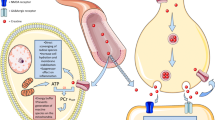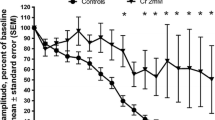Abstract
The creatine/phosphocreatine system carries ATP from production to consumption sites and buffers the intracellular content of ATP at times of energy deprivation. The creatine transporter deficiency syndrome is an X-linked disease caused by a defective creatine transporter into the central nervous system. This disease is presently untreatable because creatine lacking its carrier cannot cross neither the blood–brain barrier nor the cell plasma membranes. Possible strategies to cure this condition are to couple creatine to molecules which have their own carrier, to exploit the latter to cross biological membranes or to modify the creatine molecule to make it more lipophilic, in such a way that it may more easily cross lipid-rich biological membranes. Such molecules could moreover be useful for treatment of stroke or other ischemic brain syndromes of normal (transporter working) tissue. In this paper we tested four molecules in in vitro hippocampal slices experiments to investigate whether or not they had a neuroprotective effect similar to that of creatine. On two of them we also performed biochemical measurements to investigate whether or not they were able to increase the creatine and phosphocreatine content of the hippocampal slices with and without block of the transporter. We found that these molecules increase levels of creatine after block of the transporter, and significantly increased the levels of phosphocreatine. Both significantly increased the total creatine content in both conditions of active and blocked transporter. This shows that these molecules are capable of entering cells through biological membranes without using the creatine transporter. By contrast, neither of them was able to delay synaptic block during anoxia of normal (transporter functioning) tissue. We conclude that these compounds might possibly be useful for therapy of creatine transporter deficiency, but further research is needed to understand their possible role in anoxia/ischemia of normal tissue.






Similar content being viewed by others
References
Wyss M, Kaddurah-Daouk R (2000) Creatine and creatinine metabolism. Physiol Rev 80(3):1107–1213
Greenhaff PL (2001) The creatine–phosphocreatine system: there’s more than one song in its repertoire. J Physiol 537(3):657. doi:10.1113/jphysiol.2001.013478
Balestrino M, Lensman M, Parodi M, Perasso L, Rebaudo R, Melani R, Polenov S, Cupello A (2002) Role of creatine and in neuronal protection from anoxic and ischemic damage. Amino Acids 23(1–3):221–229. doi:10.1007/s00726-001-0133-3
Perasso L, Spallarossa P, Gandolfo C, Ruggeri P, Balestrino M (2013) Therapeutic use of creatine in brain or heart ischemia: available data and future perspectives. Med Res Rev 33(2):336–363. doi:10.1002/med.20255
Klivenyi P, Ferrante RJ, Matthews RT, Bogdanov MB, Klein AM, Andreassen OA, Mueller G, Wermer M, Kaddurah-Daouk R, Beal MF (1999) Neuroprotective effects of creatine in a transgenic animal model of amyotrophic lateral sclerosis. Nat Med 5:347–350. doi:10.1038/6568
Adhihetty PJ, Beal MF (2008) Creatine and its potential therapeutic value for targeting cellular energy impairment in neurodegenerative diseases. Neuromol Med 10(4):275–290. doi:10.1007/s12017-008-8053-y
Beal MF (2011) Neuroprotective effects of creatine. Amino Acids 40(5):1305–1313. doi:10.1007/s00726-011-0851-0
Wang J, Xiao Y, Chen S, Zhong C, Luo M, Luo H (2012) Creatine for Parkinson’s disease. Cochrane Database Syst Rev Issue 2. doi:10.1002/14651858.CD009646
Perasso L, Cupello A, Lunardi GL, Principato C, Gandolfo C, Balestrino M (2003) Kinetics of creatine in blood and brain after intraperitoneal injection in the rat. Brain Res 974(1–2):37–42. doi:10.1016/S0006-8993(03)02547-2
Lunardi G, Parodi A, Perasso L, Pohvozcheva AV, Scarrone S, Adriano E, Florio T, Gandolfo C, Cupello A, Burov SV, Balestrino M (2006) The creatine transporter mediates the uptake of creatine by brain tissue, but not the uptake of two creatine-derived compounds. Neuroscience 142(4):991–997. doi:10.1016/j.neuroscience.2006.06.058
Snow RJ, Murphy RM (2001) Creatine and the creatine transporter: a review. Mol Cell Biochem 224(1–2):169–181. doi:10.1023/A:1011908606819
deGrauw TJ, Cecil KM, Byars AW, Salomons GS, Ball WS, Jakobs C (2003) The clinical syndrome of creatine transporter deficiency. Mol Cell Biochem 244(1–2):45–48. doi:10.1023/A:1022487218904
Salomons GS, van Dooren SJ, Verhoeven NM, Marsden D, Schwartz C, Cecil KM, DeGrauw TJ, Jakobs C (2003) X-linked creatine transporter defect: an overview. J Inherit Metab Dis 26(2–3):309–318
Rosenberg EH, Almeida LS, Kleefstra T, deGrauw RS, Yntema HG, Bahi N, Moraine C, Ropers HH, Fryns JP, deGrauw TJ, Jakobs C, Salomons GS (2004) High prevalence of SLC6A8 deficiency in X-linked mental retardation. Am J Hum Genet 75(1):97–105. doi:10.1086/422102
Newmeyer A, Cecil KM, Schapiro M, Clark JF, Degrauw TJ (2005) Incidence of brain creatine transporter deficiency in males with developmental delay referred for brain magnetic resonance imaging. J Dev Behav Pediatr 26(4):276–282. doi:10.1097/00004703-200508000-00003
Clark AJ, Rosenberg EH, Almeida LS, Wood TC, Jakobs C, Stevenson RE, Schwartz CE, Salomons GS (2006) X-linked creatine transporter (SLC6A8) mutations in about 1% of males with mental retardation of unknown etiology. Hum Genet 119(6):604–610. doi:10.1007/s00439-006-0162-9
Lion-François L, Cheillan D, Pitelet G, Acquaviva-Bourdain C, Bussy G, Cotton F, Guibaud L, Gérard D, Rivier C, Vianey-Saban C, Jakobs C, Salomons GS, des Portes V (2006) High frequency of creatine deficiency syndromes in patients with unexplained mental retardation. Neurology 67(9):1713–1714. doi:10.1212/01.wnl.0000239153.39710.81
Arias A, Corbella M, Fons C, Sempere A, García-Villoria J, Ormazabal A, Poo P, Pineda M, Vilaseca MA, Campistol J, Briones P, Pàmpols T, Salomons GS, Ribes A, Artuch R (2007) Creatine transporter deficiency: prevalence among patients with mental retardation and pitfalls in metabolite screening. Clin Biochem 40(16–17):1328–1331. doi:10.1016/j.clinbiochem.2007.07.010
Burov S, Leko M, Dorosh M, Dobrodumov A, Veselkina O (2011) Creatinyl amino acids—new hybrid compounds with neuroprotective activity. J Pept Sci 17(9):620–626. doi:10.1002/psc.1379
Perasso L, Lunardi G, Risso F, Pohvozcheva A, Leko M, Gandolfo C, Florio T, Cupello A, Burov S, Balestrino M (2008) Protective effects of some creatine derivatives in brain tissue anoxia. Neurochem Res 33:765–775. doi:10.1007/s11064-007-9492-9
Balestrino M, Rebaudo R, Lunardi G (1999) Exogenous creatine delays anoxic depolarization and protects from hypoxic damage: dose-effect relationship. Brain Res 816:124–130. doi:10.1016/S0006-8993(98)01131-7
Millo E, Balestrino M, Damonte G, Garbati P, Adriano E, Salis A (2012) Procedimento per sintetizzare derivati della creatina. Patent number TO2012 A001098
Garbati P, Salis A, Adriano E, Galatini A, Damonte G, Balestrino M, Millo E (2013) A new method to synthesize creatine derivatives. Amino Acids 44(6):1–13. doi:10.1007/s00726-013-1525-x
Adriano E, Garbati P, Damonte G, Salis A, Armirotti A, Balestrino M (2011) Searching for a therapy of creatine transporter deficiency: some effects of creatine ethyl ester in brain slices in vitro. Neuroscience 199:386–393. doi:10.1016/j.neuroscience.2011.09.018
Andersen P, Bliss TV, Skrede KK (1971) Unit analysis of hippocampal population spikes. Exp Brain Res 13:208–221. doi:10.1007/BF00234086
Ballanyi K (1999) In vitro preparations. In: Windhorst U, Johansson H (eds) Modern techniques in neuroscience research. Springer, Heidelberg, pp 307–326
Whittingham TS, Lipton P (1981) Cerebral synaptic transmission during anoxia is protected by creatine. J Neurochem 37:1618–1621
Kass IS, Lipton P (1989) Protection of hippocampal slices from young rats against anoxic transmission damage is due to better maintenance of ATP. J Physiol 413:1–11
Schedel JM, Tanaka H, Kiyonaga A, Shindo M, Schutz Y (1999) Acute creatine ingestion in human: consequences on serum creatine and creatinine concentrations. Life Sci 65(23):2463–2470. doi:10.1016/S0024-3205(99)00512-3
Dai W, Vinnakota S, Qian X, Kunze DL, Sarkar HK (1999) Molecular characterization of the human CRT-1 creatine transporter expressed in Xenopus oocytes. Arch Biochem Biophys 361:75–84. doi:10.1006/abbi.1998.0959
Smith PK, Krohon RI, Hermanson GT, Mallia AK, Gartner FH, Provenzano MD, Fujimoto EK, Goeke NM, Olson BJ, Klenk DC (1985) Measurement of protein using bicinchoninic acid. Anal Biochem 150(1):76–85
Bergmeyer HU (1974) In: Bergmeyer HV (ed) Methods of enzymatic analysis, vol 1. Verlag Chemie/Academic Press, New York/London, pp 425–426
Song W, Chattipakorn SC, McMahon LL (2006) Glycine-gated chloride channels depress synaptic transmission in rat hippocampus. J Neurophysiol 95(4):2366–2379. doi:10.1152/jn.00386.2005
Betz H (1992) Structure and function of inhibitory glycine receptors. Q Rev Biophys 25:381–394
Kirsch J (2006) Glycinergic transmission. Cell Tissue Res 326(2):535–540. doi:10.1007/s00441-006-0261-x
Barth A, Nguyen LB, Barth L, Newell DW (2004) Glycine-induced neurotoxicity in organotypic hippocampal slice cultures. Exp Brain Res 161(3):351–357. doi:10.1007/s00221-004-2079-7
Saransaari P, Oja SS (2001) Characteristics of hippocampal glycine release in cell-damaging conditions in the adult and developing mouse. Neurochem Res 26(7):845–852. doi:10.1023/A:1011624421505
Prass K, Royl G, Lindauer U, Freyer D, Megow D, Dirnagl U, Stöckler-Ipsiroglu G, Wallimann T, Priller J (2007) Improved reperfusion and neuroprotection by creatine in a mouse model of stroke. J Cereb Blood Flow Metab 27(3):452–459. doi:10.1038/sj.jcbfm.9600351
Author information
Authors and Affiliations
Corresponding author
Additional information
Patrizia Garbati and Enrico Adriano have contributed equally to this work.
Rights and permissions
About this article
Cite this article
Garbati, P., Adriano, E., Salis, A. et al. Effects of Amide Creatine Derivatives in Brain Hippocampal Slices, and Their Possible Usefulness for Curing Creatine Transporter Deficiency. Neurochem Res 39, 37–45 (2014). https://doi.org/10.1007/s11064-013-1188-8
Received:
Revised:
Accepted:
Published:
Issue Date:
DOI: https://doi.org/10.1007/s11064-013-1188-8




